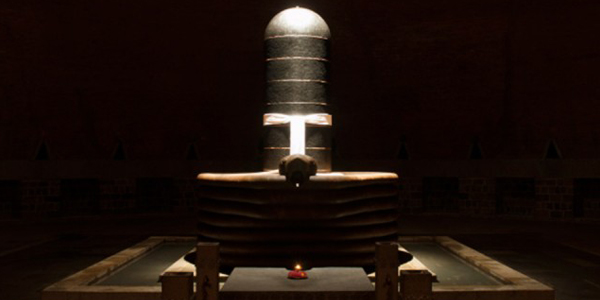In Search of Shiva

“He is described as the ‘dark one’ — the boundless emptiness in which all Creation rests.” —Sadhguru
Mahashivarathri is just a month away. In the lead up to the dark night, we bring you a sharing by a seeker – the transformative experience of the way Shiva “derailed” her life when she first visited Dhyanalinga as an NRI student a few years ago.
The tyres of the taxi screeched to a halt on the gravelly path, and I knew the bumpy ride had finally come to an end. When I opened the door, my foreign eyes were greeted with a thick green forest that surrounded me, which as I learnt later, was teeming with hidden wildlife. I stepped gingerly onto a pebbled patch and followed my parents towards a little shack with a thatched roof, nestled in the shrubs. There, a smiling south Indian face welcomed us and led us further into the wilderness and into a large stone structure. I walked past granite pillars and engravings towards the entrance of a huge dome, which was dimly lit inside.
A New Experience
A bespectacled, shaven-head monk dressed in white received us. As the monk grinned cheerfully, I noticed with mild shock that it was a woman, a brahmacharini. She indicated for us to maintain silence and to mute our digital wristwatches. Only later, I realised that if she had not given this necessary instruction, I would have missed out on the whole experience. Through silent gestures, we entered the dome and sat down. Inside, at the center, was a huge linga, the largest I had ever seen. It was dark and bare, except for the long garland of flowers draping it.
This had something to do with Shiva – even my American-born Indian mind could figure that out. I had not been to many as my family was basically from a Vaishnava background. But as my mother was adamant that we visit this particular place in Tamil Nadu, my father and I had no choice. It hardly mattered to me, a college student spending her summer holidays in her ancestral country — I was just on another interesting excursion away from textbooks. The last thing I expected was to walk into a place that would change the very course of my life.
I stared at the linga for a few minutes. Then the deafening silence slowly permeated me and I felt myself sinking into dark emptiness behind closed eyelids. An overpowering stillness set in, and my body and mind seemed to recede into the distance. I was transported to another world, a vast uncharted inner world which I had never encountered before. In this dimension of eternal and primordial silence, my petty existence was just a temporary happening. It totally overwhelmed the miniscule me. Minutes slipped by, and I don’t know how long I sat there. Before I knew it, my father was urging me to get up. In a daze, I stepped out into the afternoon sunlight, bewildered. It was by far the strangest place I had ever visited.
Searching for Shiva
I had always thought place of worship were rather obnoxious places, and was always a reluctant visitor. I was used to the dirt, the noise of bells ringing, and the boredom of incessant chanting of mantras that accompanied endless rituals. But this place was utterly quiet, without a single pooja, and indisputably clean. The visit erased my prejudice and opened up a new window, igniting a curiosity to know more about Shiva.
I started reading. I knew Shiva was part of the Hindu pantheon of gods, whose role was that of the destroyer. I learnt that at one time in India most temples were dedicated to Shiva, and it was only much later that other temples started cropping up.
The ancients prayed to him not for protection or prosperity but for destruction! They wanted him to annihilate their finite existence so they could attain the infinite. He is described as the “dark one” — the boundless emptiness in which all Creation rests. He is known to be an indifferent ascetic, a passionate husband and a drunkard in the company of freaky goblins. His dance of ecstasy brings forth creation, and his fiery rage scorched the god of love. Was he a good guy or a bad guy? At times he seemed like the epitome of all things good, at other times he was such a hideous creature that I would not want to be anywhere near him. I didn’t know what to make of him. He encompassed everything I valued and abhorred at once.
Falling for Shiva
I couldn’t explain Shiva so easily. As I read further, the confusion only deepened. Was he a person or was he the very basis of existence – or both? My longing to know only grew more intense, and after a couple of years I began my spiritual search in earnest to experience the Truth. I began practicing meditation and pranayama, and underwent various yoga programs, experiencing a few moments where stillness and silence washed over me. Those moments spurred me further on my quest and still continue to do so.
Four years after that first visit, I returned, and this time for good. Somewhere it had touched me so deeply that I just couldn’t stay away. Hardly a day passes when I don’t spend time meditating near the linga. Every time I enter the place and close my eyes, thinking I know what to expect, the experience catches me off guard. Being there is like being in the presence of something far bigger than me, an all-encompassing living entity.
I don’t think names matter, but what I call Shiva is not a person or a god that people can like or dislike. He is something beyond boundaries of human logic and definition, beyond time and space. He is a constant, undeniable presence and absence. He is the Ultimate possibility that I hope to become, one day.
Editor’s Note: This year, Mahashivarathri falls on 27 February. At the Isha Yoga Center, the nightlong celebration with Sadhguru will include Sadhguru’s discourses and powerful meditations, along with musical performances by the likes of Pandit Jasraj.
Isha is launching an online Thunderclap Campaign to take Shiva to the world! Join us if you’d like to make some “noise” and spread the word about Mahashivarathri. All it takes is a tweet. (Facebook messages also make a lot of noise!)


